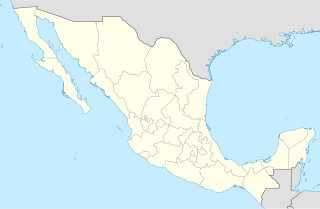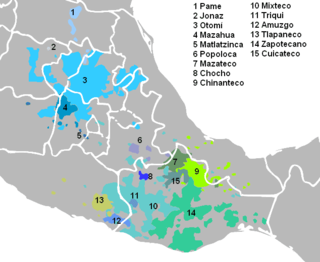A zoo is a place where all animals are exhibited.

The Zapotec languages are a group of around 50 closely related indigenous Mesoamerican languages that constitute a main branch of the Oto-Manguean language family and which is spoken by the Zapotec people from the southwestern-central highlands of Mexico. The 2010 Mexican census reports 425,000 speakers, with the majority inhabiting the state of Oaxaca. Zapotec-speaking communities are also found in the neighboring states of Puebla, Veracruz, and Guerrero. Labor migration has also brought a number of native Zapotec speakers to the United States, particularly in California and New Jersey. Most Zapotec-speaking communities are highly bilingual in Spanish.
A macrolanguage is a book-keeping mechanism for the ISO 639 international standard for language codes. Macrolanguages are established to assist mapping between different sets of ISO language codes. Specifically, there may be a many-to-one correspondence between ISO 639-3, intended to identify all the thousands of languages of the world, and either of two other sets, ISO 639-1, established to identify languages in computer systems, and ISO 639-2, which encodes a few hundred languages for library cataloguing and bibliographic purposes. When such many-to-one ISO 639-2 codes are included in an ISO 639-3 context, they are called "macrolanguages" to distinguish them from the corresponding individual languages of ISO 639-3. According to the ISO,
Some existing code elements in ISO 639-2, and the corresponding code elements in ISO 639-1, are designated in those parts of ISO 639 as individual language code elements, yet are in a one-to-many relationship with individual language code elements in [ISO 639-3]. For purposes of [ISO 639-3], they are considered to be macrolanguage code elements.

The Zapotec civilization was an indigenous pre-Columbian civilization that flourished in the Valley of Oaxaca in Mesoamerica. Archaeological evidence shows that their culture goes back at least 2,500 years. The Zapotec left archaeological evidence at the ancient city of Monte Albán in the form of buildings, ball courts, magnificent tombs and grave goods including finely worked gold jewelry. Monte Albán was one of the first major cities in Mesoamerica and the center of a Zapotec state that dominated much of the territory that today belongs to the Mexican state of Oaxaca.

Magdalena Mixtepec is a town and municipality in Oaxaca in south-western Mexico. The municipality covers an area of 11.48 km². It is part of the Zimatlán District in the west of the Valles Centrales Region

Juquila District is located in the center of the Costa Region of the State of Oaxaca, Mexico, on the Pacific coast. It has an area of 5,055 km2. As of 2005 it had a total population of 134,365 of whom 33,106 spoke an indigenous language. Economic activities include agriculture and tourism. The Santuario (Sanctuary) de Juquila is a major attraction.

The internal classification of Mixtec is controversial. Many varieties are mutually unintelligible and by that criterion separate languages. In the 16th century, Spanish authorities recognized half a dozen lenguas comprising the Mixtec lengua. It is not clear to what extent these were distinct languages at the time. Regardless, the colonial disintegration of the Mixtec nation and resulting isolation of local communities led to the rapid diversification of local dialects into distinct languages. Below are some attempts at Mixtec classification by various scholars.
Mixtepec Zapotec is an Oto-Manguean language of Oaxaca, Mexico. It is reported to have 80% intelligibility with Lapaguía Zapotec, but with only 45% intelligibility in the other direction.
Zaniza Zapotec is an Oto-Manguean language of western Oaxaca, Mexico. It is one of several Zapotec languages called Papabuco. It has only 10% intelligibility with Texmelucan Zapotec, its closest important relative.
Lachixío Zapotec is a Zapotec language of Oaxaca, Mexico. It is spoken in the Sola de Vega District by around 3000 speakers in Santa María Lachixío and San Vicente Lachixío. While many other Zapotec languages have suffered major language shifts to Spanish, most children in these towns are raised with Zapotec and learn Spanish at an early age.
Tlacolula Valley Zapotec or Valley Zapotec, formerly known by the varietal name Guelavia Zapotec is a Zapotec language of Oaxaca, Mexico.
Ixtlán Zapotec is a Zapotec dialect cluster of Oaxaca, Mexico.
Several Zapotec languages are called "Mixtepec", after the main town they are spoken in. They include:
San Agustín Mixtepec Zapotec is a nearly extinct Zapotec language of Oaxaca, Mexico.
Mixtepec Mixtec is a Mixtec language spoken in the town of San Juan Mixtepec, Oaxaca, and in nearby towns, and by emigrants in California. It is not closely related to other varieties of Mixtec.
Zapoteco de la Sierra sur, noroeste is a name used by INALI for a variety of Zapotec recognized by the Mexican government. It corresponds to three ISO languages:
San Juan Mixtepec may refer to:






